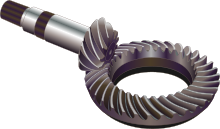Two important concepts in gearing are pitch surface and pitch position. The pitch surface of a gear may be the imaginary toothless surface that you would possess by 
The most familiar kinds of bevel gears have pitch angles of less than 90 degrees and therefore are cone-shaped. This type of bevel gear is named external since the gear teeth point outward. The pitch surfaces of meshed external bevel gears are coaxial with the apparatus shafts; the apexes of the two areas are at the point of intersection of the shaft axes.
Bevel gears which have pitch angles of greater than ninety degrees have teeth that time inward and are called internal bevel gears.
Bevel gears which have pitch angles of specifically 90 degrees possess teeth that time outward parallel with the axis and resemble the factors on a crown. That is why this type of bevel gear is named a crown gear.
Mitre gears are planetary gearbox mating bevel gears with equal amounts of teeth and with axes at right angles.
Skew bevel gears are those that the corresponding crown equipment has the teeth that are directly and oblique.